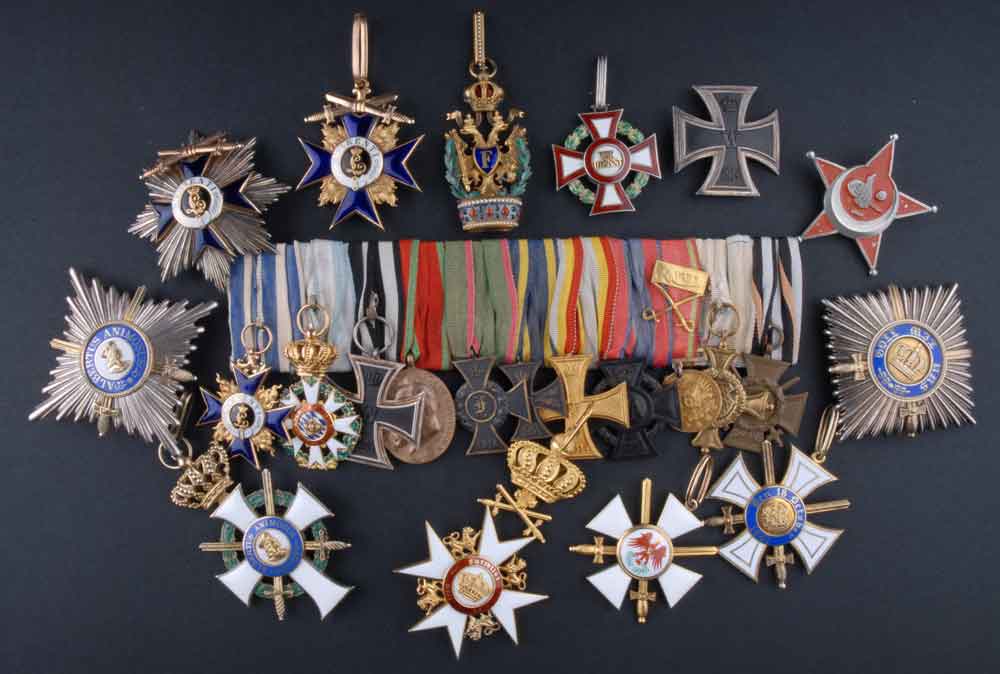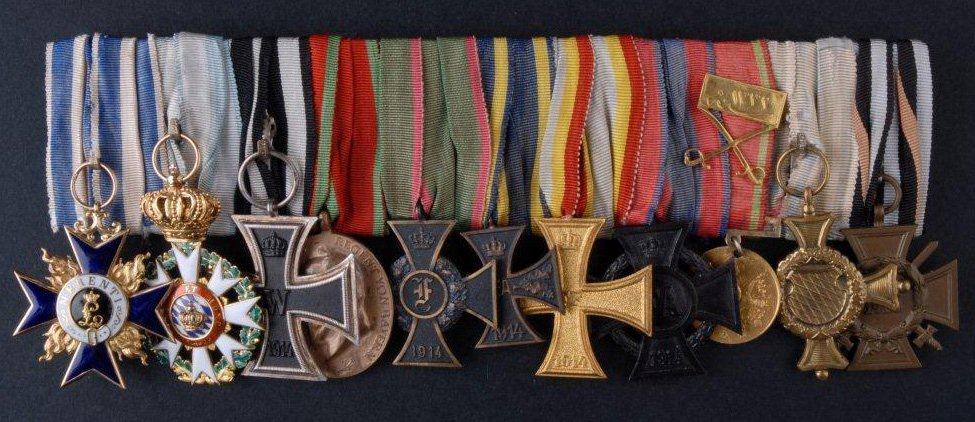-
Posts
1,147 -
Joined
-
Last visited
-
Days Won
12
Content Type
Profiles
Forums
Blogs
Gallery
Events
Store
Posts posted by Elmar Lang
-
-
Hello,
here's the picture of the whole group of orders & decorations. The ribbons are lost, since all pieces were put together in a frame. Along with the group there are many interesting papers and some pictures.
As you can see, in the group there are some rare pieces: the Red Eagle Cross with swords is in gold, same as the Bavarian Military Merit Order with star; the Crown Order with Swords (Württemberg) is also in gold; the other pieces are in gilt silver or silver and the austrian Iron Crown 2nd Class with War Decoration is a fine piece in gilt bronze.
Back to the Ordensspange, the MVO III Class, the Order of the Bavarian Crown and the Turkish medal are in gold.
Best wishes,
Elmar Lang
 0
0 -
I'll do that as soon as possible!
E.L.
0 -
Hello,
this is the Große Ordensspange belonged to General Eugen Ritter von Zoellner. It comes directly from his heirs and -together with his complete group of orders and decorations, it will be offered in auction soon.
Best wishes,
Elmar Lang
 0
0 -
me, humbly...
0 -
They simply are two laurel branches of the Belgian "Croix de Guerre" with the monogram of the kings Albert and Leopold.
The Italian WW1 commemorative medals should have the bars with the years from 1915 to 1918 and the bar "Albania".
Best wishes,
Elmar Lang
0 -
Hello,
I've taken the weight of my Silberne Tapferkeitsmedaillen 2nd Class.
Type 1849-1859: 18,1 g.
Type 1859-1866: 17,5 g.
the first, including ribbon (it is originally sewn to the piece, so I haven't removed it); the second, without ribbon.
I hope this could help.
Best wishes,
Elmar Lang
0 -
Hello,
I've met Mr. Rochowanski and his wife the first time in 1979, during one of my first trips to Vienna. I can say that they've always been more than kind; everything I was curious about the history, details and data of a certain austrian decoration or order always had a proper and detailed answer. Any time I meet them it's a real pleasure.
Mr. Rochowanski is a true gentleman, beides being a living "archive" of Imperial austrian phaleristic.
Best wishes,
E.L.
0 -
Hello,
the text written on the back of your picture says:
To you, Mom
to you Elny and Rosetta
with love and...
remember me,
truly yours
...
December 5th, 1950
I hope this would help,
best wishes,
Elmar Lang
0 -
the Silver Medals for Tyrol, 1797, when in very fine condition, can have a value of approx. 200,-/250,- $
Small and large gold medals are difficult to be estimated, due to their rarity.
Best wishes,
E.L.
0 -
Don't feel worried: I don't remember any large Gold 1797 Medal on the market since many, many years...
E.L.
0 -
Hello,
this very interesting medal was awarded to soldiers and non commissioned officers of the tyrolean troops in silver (like your piece); in gold (smaller size) to officers and also in gold (of larger size) to corps commanders (the medals in gold are extremely rare...).
Best wishes,
E.L.
0 -
You're welcome, Ivan.
Pity, I don't have my "Rangliste" here, and I'll be back home in 12 days. I hope it wouldn't be so urgent...
Best wishes,
E.L.
0 -
Hello,
the 1918 "Rangliste" reports Hauptmann (1. Mai 1914) Emil Piletschka, in Infantry Regiment 100., decorated with the Bronzene Militärverdienstmedaille (War Ribbon), 1848-1908 Jubilee Cross and "Erinnerungskreuz 1912-13".
Best wishes,
E.L.
0 -
...in a relatively recent past, they weren't that difficult to find and not particularly expensive....
The truth is that the 1st type is a very very rare decoration.
Best wishes,
E.L.
0 -
Hello,
the royal monograms gold-embossed on the cases, as pictured in the above post, are correctly referring resp. to king Victor Emanuel II (as 1st King of Italy), then king Humbert I (killed in 1900 by an anarchist) and king Victor Emanuel III. It appears evident the calligraphic difference between the monograms of both Victor Emanuels. The last king of Italy, Humbert II, rarely used monogrammed cases: I personally know a case of a Commander's Cross of the Order of the Crown of Italy, awarded early in 1946, without any royal cypher.
The colour of the centre medallion: while it is sure that a cross with pale blue enamelled obverse centre medallion is an early piece, this cannot be a rule with dark blue enamelled centres: those made by the turin firm of Messrs. Pernetti are usually with dark blue enamelled obverse medallions, and such Turin-made pieces are the earliest of all.
The florentine jewellers Fratelli Borani were the official suppliers for this order in the short period when the capital city of Italy moved from Turin to Florence. Borani, after 1870, moved to Rome, opening his jewellery shop: this firm, later became Cravanzola and, later, Gardino.
Early insignia of the Crown Order are characterized by thicker Savoy knots, while later ones have the knots made by thinner gold wire. Pieces made in Turin earlier than 1870 are often struck with an "eagle's head" mark (meaning the manufacture in gold).
Best wishes,
Elmar Lang
0 -
Nice cases indeed, especially the oldest type: I hope you will be able to "fill" it soon!
Best wishes,
E.L.
0 -
Hello,
from what I can see looking at Medalhouse's webpage, there is no notice of it being closed.
Best wishes,
E.L.
0 -
I can only quote the title of a pavian, composed by master Dowland: "flow, my tears"...
Enzo
0 -
Now... it would be very nice to see the fine Mayer's Söhne-made cross inside the case!
Beautiful piece indeed.
Enzo
0 -
Hello,
my opinion about the possibility that this star could have been made by Olszewski is based upon the type of broad pin/hinge (from what I can see in the picture), closely resembling the reverse of a POLONIA RESTITUTA star, indicated as a copy made by that Warsaw-based firm, illustrated in W. Stela: Polskie Ordery i Odznaczenia; Warsaw, 2010, vol. II page 158.
The type of star (rays) doesn't necessarily seem like the copies of Souval: it's after one of the types of rays as used in Russian orders, more or less.
Besides that, this same star, was sold in auction at Thies' (sale nr.33 - October 15th, 2007, lot 249, start price Euro 1.200,- where the lot remained unsold). Mr. Thies, who definitely is a deep expert, catalogued that piece, among other russian and soviet ones (lots 207-690) offering them "as is", without any warranty.
Best wishes,
Elmar Lang
0 -
Hello,
why Souval?
The broad pin allows me to think about a polish production like Olszewski etc.
Elmar Lang
0 -
Hello,
yesterday I've visited my mother and have found, in my father's library, an example of the 1816 statutes and a VERY erarly knight's cross, with "smooth" white enamel.
I hope this will be useful to all of us.
Best wishes,
E.L.
0 -
Hello,
in my late father's library there should be an ancient statutes' book of this order. I'll take it at home as soon as possible and search for possible details.
What I can say is that the crosses of the Order of St. Maurice & Lazarus had the St. Maurice cross with "smooth" white enamel in the pieces dating from the 18th Century. From the early 19th C., the "trefoil" shaped endings were even more and more raised, until they became like three "balls".
Best wishes,
Elmar Lang
0 -
This document is of the highest documentary importance in the phaleristical history of Albania (and Italy, of course!).
Thank you Artan!
Enzo (Elmar Lang)
0




Imperial Austrian Military Merit Cross
in Austro-Hungarian Empire
Posted · Edited by Elmar Lang
Hello,
I think that the use of the word "Fortitudini" to Emperor Karl's Tapferkeitsmedaillen wasn't necessarily to be more "neutral" towards the opposition, but to exalt the importance of this decoration, giving to it the motto of the Military Order of Maria Theresia. On the other hand, "Fortitudini" and "der Tapferkeit" have the same meaning.
Best wishes,
Elmar Lang